Is Yunnan small grain coffee delicious? Let's make a real Yunnan Tieka coffee!
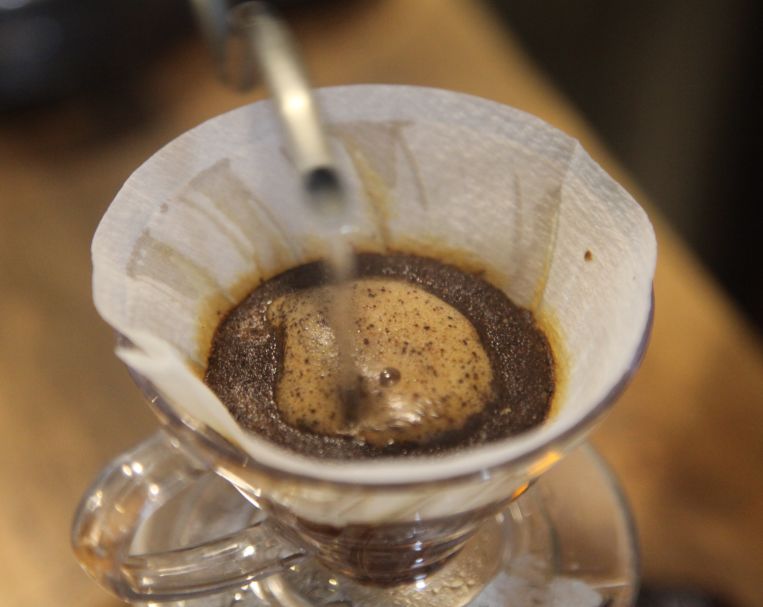
Professional coffee knowledge exchange More coffee bean information Please pay attention to coffee workshop (Weixin Official Accounts cafe_style)
01 |Introduction to Yunnan Arabica Coffee Production Area
Yunnan Arabica coffee suitable for growth in the mountains 800~1800 meters above sea level, if the altitude is too high, sour taste, too low taste bitter. Yunnan Arabica coffee is mostly planted in dry and hot valley areas with an altitude of about 1100 meters, so the sour taste is moderate, the flavor is rich and mellow. Many areas of Yunnan have a unique environment suitable for the growth of small coffee, Yunnan small coffee produced excellent quality.
Planting areas are mainly distributed in Lincang, Baoshan, Simao, Xishuangbanna, Dehong and other prefectures. Baoshan has an average temperature of 21.5℃ and a maximum temperature of 40.4℃. There is basically no frost all year round. It is recognized as the best producing area of Yunnan Arabica coffee. Yunnan Arabica coffee cultivated here is famous for its strong but not bitter, fragrant but not strong, well-proportioned grain facets, mellow fragrance and fruity flavor. International coffee tasting experts evaluated Yunnan Arabica coffee as Colombia wet-processed Arabica coffee, the highest quality coffee in the world.
Planting height:
For Arabica, 1200 is a watershed in quality. You will find that Hainan coffee, which almost no one talks about, has always been in the non-mainstream and can only be sold as a tourist souvenir. First, it is because it is Luo Dou, and second, because Hainan is located at sea level, most places are 300 meters below sea level. There are 1800 points in Wuzhishan in the middle, and only 320 in urban areas. Hainan can grow some souvenir coffee, for planting a good Arabica, it is really more than enough.
Since planting height is the basic factor, large mountainous areas in Yunnan can reach more than 1000 meters above sea level. Kunming is 1895 meters above sea level. Baoshan is 1653.5 meters above sea level. Dali is 1976 meters above sea level. Chuxiong is 1773 meters above sea level. Dehong has an average altitude of 800~1500 meters. Diqing has an average altitude of 3380 meters. The altitude is high, and then consider the temperature. Generally speaking, the golden coffee belt is between the north and south tropics. The reason is that the probability of frost is very high, and the coffee tree will die in case of frost. In Yunnan, there is a Gaoligong Mountain in the north of Baoshan, which blocks the influence of Siberian cold current in winter and forms a protective climate for coffee growth.
02 |treatment
Harvested berries are peeled to remove most of the pulp from the beans. The beans are then directed to a clean tank where they are soaked in water for fermentation to remove the remaining pulp layer. In the past (about five years ago), washing was often the preferred method of preparing good coffee beans.
Through water treatment, immature beans and defective beans are selected due to buoyancy, and the fermentation process is better controlled, so the flavor is not as messy as sun-baked beans, but presents obvious acidity, slightly more complexity and cleaner cup characteristics (no negative flavor, such as astringency or sharpness). However, it is also because it is too "clean" and the richness of flavor is slightly weaker.
03 |green bean analysis
Coffea yunnanensis
Yunnan arabica coffee, rubiaceae, coffee, planting area is mainly distributed in Lincang, Baoshan, Simao, Xishuangbanna, Dehong and other prefectures. Arabica coffee is native to Ethiopia or the Arabian Peninsula.
varieties
Typica: The oldest indigenous variety of Ethiopia, native to Ethiopia and southeastern Sudan, from which all Arabica is derived. Elegant flavor, but weak constitution, poor disease resistance, fruit yield less. Jamaica Blue Mountain, Sumatra Mantning, Hawaii Kona and other excellent estate beans belong to Tibika. The top leaf of tibeka is red copper color, called red top coffee, tibeka belongs to arabica.
Coffee tree opposite leaves are long oval, leaf surface smooth, terminal branches are very long, few branches, and flowers are white, open at the base of the petiole connecting branches. Mature coffee berries look like cherries, are bright red, sweet flesh, containing a pair of seeds, namely coffee beans (Coffee Beans).
Typica Typica is one of the oldest native varieties in Ethiopia. The top leaves of Typica are bronze, the beans are oval or thin and pointed; the flavor is elegant, but the constitution is weak, the disease resistance is poor, and the fruit yield is small.
Typica is one of the oldest varieties of Arabica coffee found today, the other being bourbon. The Arabica species originated in Ethiopia, where it still grows naturally today in the pristine rainforest upland. Java's tinplate card, a Dutch gift to Louis XIV of France, survived in Persian gardens and produced seeds that were brought to Martinique by the French in 1720.
Iron pickup bean slender, tall tree, fruit oval, branches slightly inclined. Four iron pickups are slender and spread out at an angle of 50 to 70 degrees. The coffee yield per tree is very low, but the cup score is high.
04 |Roasting Analysis of Yunnan Arabica Coffee
This coffee is intended to be medium slow roasted to best reflect its round, smooth, fruity and fruity characteristics.
Baking machine Yangjia 600g semi-straight fire
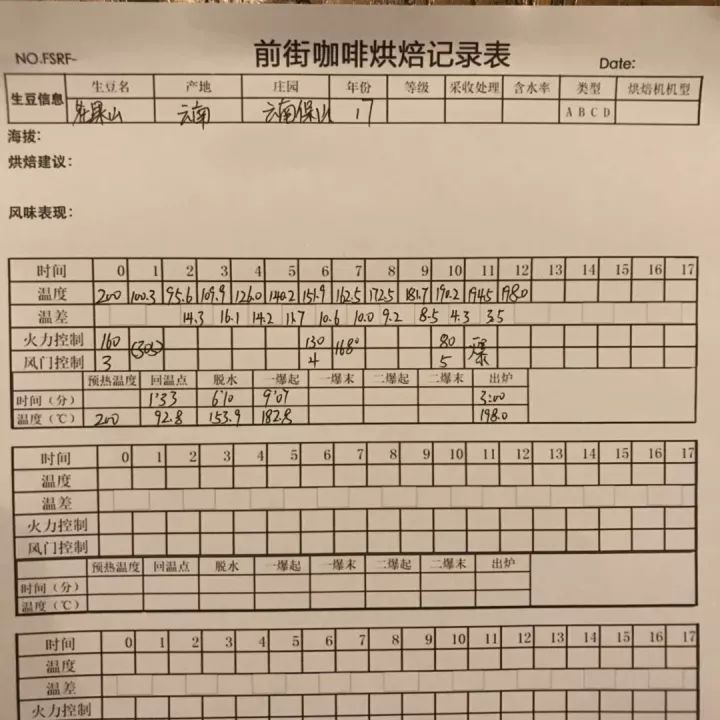
Heat the oven to 200 degrees Celsius, open the damper for 3 seconds, adjust the fire to 160 degrees Celsius, keep the damper unchanged, return to temperature point 1 '33', adjust the fire once at 168 degrees Celsius, at this time the bean surface turns yellow, the grass smell completely disappears, dehydration is completed, the fire is adjusted to 130 degrees Celsius, the damper is adjusted to 4;
8 ′ 45 ′ ′, the bean surface appears ugly beard wrinkles and black stripes, toast flavor obviously changed to coffee fragrance, can be defined as the prelude to a burst, this time to hear the sound of a burst point, to 9 ′ 07 ″ to start a burst, turn down the fire to 80 degrees, throttle fully open 5 (adjust the fire to be very careful, not small to no burst sound), a burst after 3 ′ 00 ″, 198 degrees under the pan.
Cup test:
Dried aroma: pear-fruit, vanila-like, honey-like, peach tea, ripe orange, jasmine hints
Wet aroma: nutty, milky chocolate, herbal
Palate: Soft on the palate, Asian herb aroma, lively and bright acidity, cheeks salivation, sour softness, mellow balance, rich layers, aftertaste dark chocolate, honey, sucrose flavor obvious, completely cooled, brown sugar flavor.
05 |Brewing Analysis of Yunnan Arabica Coffee
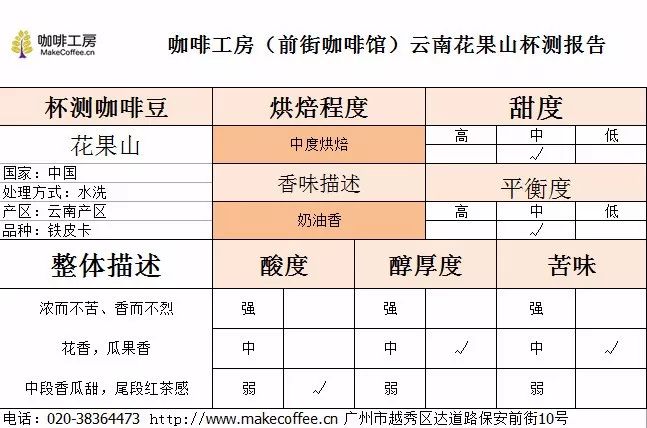
Recommended cooking methods: siphon, hand brewing
Abrasion: 4 (Fuji R440)
Water temperature: 90°C
V60 filter cup, 15 grams of powder, water temperature 90 degrees, grinding 4, water powder ratio close to 1:15
30g water steams for 30s
Staging: water injection to 99ml water cut, slow water injection to 230ml
31-99-100.
Other suggestions for trickle-filtration extraction:
Normal pressure, recommended abrasiveness of 3.5-4/water temperature 90°C
Aile pressure, recommended 2.5 grind, water temperature 88°C
Hand washing: 3.5 grinding degree, water temperature 89°C
Qianjie Coffee: Guangzhou's baking shop, small store but a variety of beans, can find a variety of famous beans, but also provide online store services. https://shop104210103.taobao.com
Important Notice :
前街咖啡 FrontStreet Coffee has moved to new addredd:
FrontStreet Coffee Address: 315,Donghua East Road,GuangZhou
Tel:020 38364473
- Prev
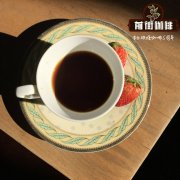
How much water do you make with 15g of hand coffee? Hand-washed Nicaraguan mountain extremely hard beans with whole berries Fakadu
Professional coffee knowledge exchange more coffee bean information please follow the coffee workshop (Wechat official account cafe_style) hand coffee 15g how much water? What are the flavor characteristics of Fakadura varieties treated with full berries of alpine hard beans in Nicaragua? Nicaraguan coffee has been forgotten in Taiwan over the years, and Nicaraguan coffee is rarely seen. In fact, the growing conditions of Nicaragua are not.
- Next
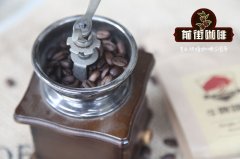
How much water do you add to Nicaragua with 15g by hand? What is the flavor and taste of the orange fruit manor in Nicaragua? Hand punch
Professional coffee knowledge exchange more coffee bean information please follow the coffee workshop (Wechat official account cafe_style) hand 15g Nicaragua how much water? What is the flavor and taste of the orange fruit manor in Nicaragua? Hand wash Nicaraguan gouache ratio? Country of production: Nicaragua, Nicaragua: Nueva Segovia Manor, New Bosnia and Herzegovina region name: orange Fruit Manor Finca
Related
- Detailed explanation of Jadeite planting Land in Panamanian Jadeite Manor introduction to the grading system of Jadeite competitive bidding, Red bid, Green bid and Rose Summer
- Story of Coffee planting in Brenka region of Costa Rica Stonehenge Manor anaerobic heavy honey treatment of flavor mouth
- What's on the barrel of Blue Mountain Coffee beans?
- Can American coffee also pull flowers? How to use hot American style to pull out a good-looking pattern?
- Can you make a cold extract with coffee beans? What is the right proportion for cold-extracted coffee formula?
- Indonesian PWN Gold Mandrine Coffee Origin Features Flavor How to Chong? Mandolin coffee is American.
- A brief introduction to the flavor characteristics of Brazilian yellow bourbon coffee beans
- What is the effect of different water quality on the flavor of cold-extracted coffee? What kind of water is best for brewing coffee?
- Why do you think of Rose Summer whenever you mention Panamanian coffee?
- Introduction to the characteristics of authentic blue mountain coffee bean producing areas? What is the CIB Coffee Authority in Jamaica?

